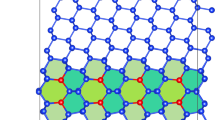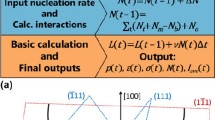Abstract
Geometrical properties form a key aspect of any description of heteroepitaxial systems in which orientation, symmetry, and lattice parameters differ. An energetically founded epitaxial criterion, which is geometric in nature, for matching at a planar interface is derived from a generalization of the Frank-van der Merwe theory and the rigid models introduced by Reiss and van der Merwe. The criterion is most naturally formulated in reciprocal space as the matching of overgrowth and substrate reciprocal lattice vectors and is visualized with a construction analogous to the Ewald construction. Structure factors are introduced and account for rigid translations and the nonprimitive nature of substrate and overgrowth surface unit cells. This article focuses on the derivation of the epitaxial criterion and its consequences as a basis of a description of epitaxial configurations, pseudomorphism, and the parameters of dislocation or misfit vernier arrays, in terms of crystallographic conventions. The strength of the description is its general nature, as it is general and applicable to any combination of crystal symmetries or mismatch and can be used to predict, or interpret, interfacial structure.
Similar content being viewed by others
References
F.C. Frank and J.H. van der Merwe: Proc. R. Soc. A, 1949, vol. 198, p. 205–16; vol. 198, p. 216–25; vol. 200, p. 125–34; and vol. 201, p. 261–68.
M.W.H. Braun: Ph.D. Thesis, University of Pretoria, Pretoria, 1987.
J.H. van der Merwe: Phil. Mag. A, 1982, vol. 45, pp. 127–43.
H. Reiss: J. Appl. Phys., 1968, vol. 39, pp. 5045–48.
N.H. Fletcher and K.W. Lodge: in Epitaxial Growth, J.W. Matthews, ed., Academic Press, New York, NY, 1975, Part B, pp. 529–57.
Y. Gotoh and T. Trai: Jpn. J. Appl. Phys., 1986, vol. 25, pp. L583-L586.
A.D. Novaco and J.P. McTague: Phys. Rev. Lett., 1977, vol. 38, pp. 1286–89.
P.M. Stoop: Master’s Thesis, University of Pretoria, Pretoria, 1986.
P.M. Stoop: Interface Sci., 1993, vol. 1, pp. 243–47.
J.H. van der Merwe, D.L. Tönsing, and P.M. Stoop: Thin Solid Films, 1994, vol. 237, pp. 297–309.
L.A. Bruce and H. Jaeger: Phil. Mag. A, 1978 vol. 38, pp. 223–40.
G. Busch and H. Schade: Lectures on Solid State Physics, Pergamon Press, Oxford, United Kingdom, 1976.
J.W. Matthews: in Epitaxial Growth, J.W. Matthews, ed., Academic Press, New York, NY, 1975, Part B, pp. 559–609.
J.H. van der Merwe: Proc. Phys. Soc. (London), 1950, vol. A 63, p. 616–37.
W.A. Jesser and D. Kuhlmann-Wilsdorf: Phys. Status Solidi, 1967, vol. 21, pp. 533–44.
W. Bollmann: Crystal Defects and Crystalline Interfaces, Springer-Verlag, Berlin, 1970.
J.H. van der Merwe and M.W.H. Braun: Appl. Surf. Sci., 1985, vol. 22–23, pp. 545–48.
J.H. van der Merwe and M.W.H. Braun: Mater. Res. Soc. Symp. Proc., 1987, vol. 77, pp. 133–44.
W.A. Jesser: Phys. Status Solidi (a), 1973, vol. 20, pp. 63–76.
J.P. Hirth and J. Lothe: Theory of Dislocations, 2nd ed., John Wiley, New York, NY, 1982, pp. 24–25 and 91.
M.W.H. Braun, H.S. Kong, J.T. Glass, and R.F. Davis: J. Appl. Phys., 1991, vol. 69, pp. 2679–81.
P.M. Stoop and J.A. Snyman: Thin Solid Films, 1988, vol. 158, pp. 151–66.
P.M. Stoop, J.H. van der Merwe, and M.W.H. Braun: Phil. Mag. B, 1991, vol. 63, pp. 907–22.
H.I. Gaigher and N.J. van der Berg: Thin Solid Films, 1987, vol. 146, pp. 299–302.
E. Bauer and J.H. van der Merwe: Phys. Rev. B, 1986, vol. 33, pp. 3657–71.
M.W.H. Braun and J.H. van der Merwe: S.A. J. Sci., 1988, vol. 84, pp. 670–71.
W. Zhu, X.H. Wang, B.R. Stoner, G.H.M. Ma, H.S. Kong, M.W.H. Braun, and J.T. Glass: Phys. Rev. B, 1993, vol. 47, pp. 6529–42.
Author information
Authors and Affiliations
Additional information
This article is based on a presentation in the symposium “Interfacial Dislocations: Symposium in Honor of J.H. van der Merwe on the 50th Anniversary of His Discovery,” as part of the 2000 TMS Fall Meeting, October 11–12, 2000, in St. Louis, Missouri, sponsored under the auspices of ASM International, Materials Science Critical Technology Sector, Structures.
Rights and permissions
About this article
Cite this article
Braun, M.W.H., Van Der Merwe, J.H. Reciprocal-space formulation and prediction of misfit accommodation in rigid and strained epitaxial systems. Metall Mater Trans A 33, 2485–2494 (2002). https://doi.org/10.1007/s11661-002-0370-4
Issue Date:
DOI: https://doi.org/10.1007/s11661-002-0370-4




